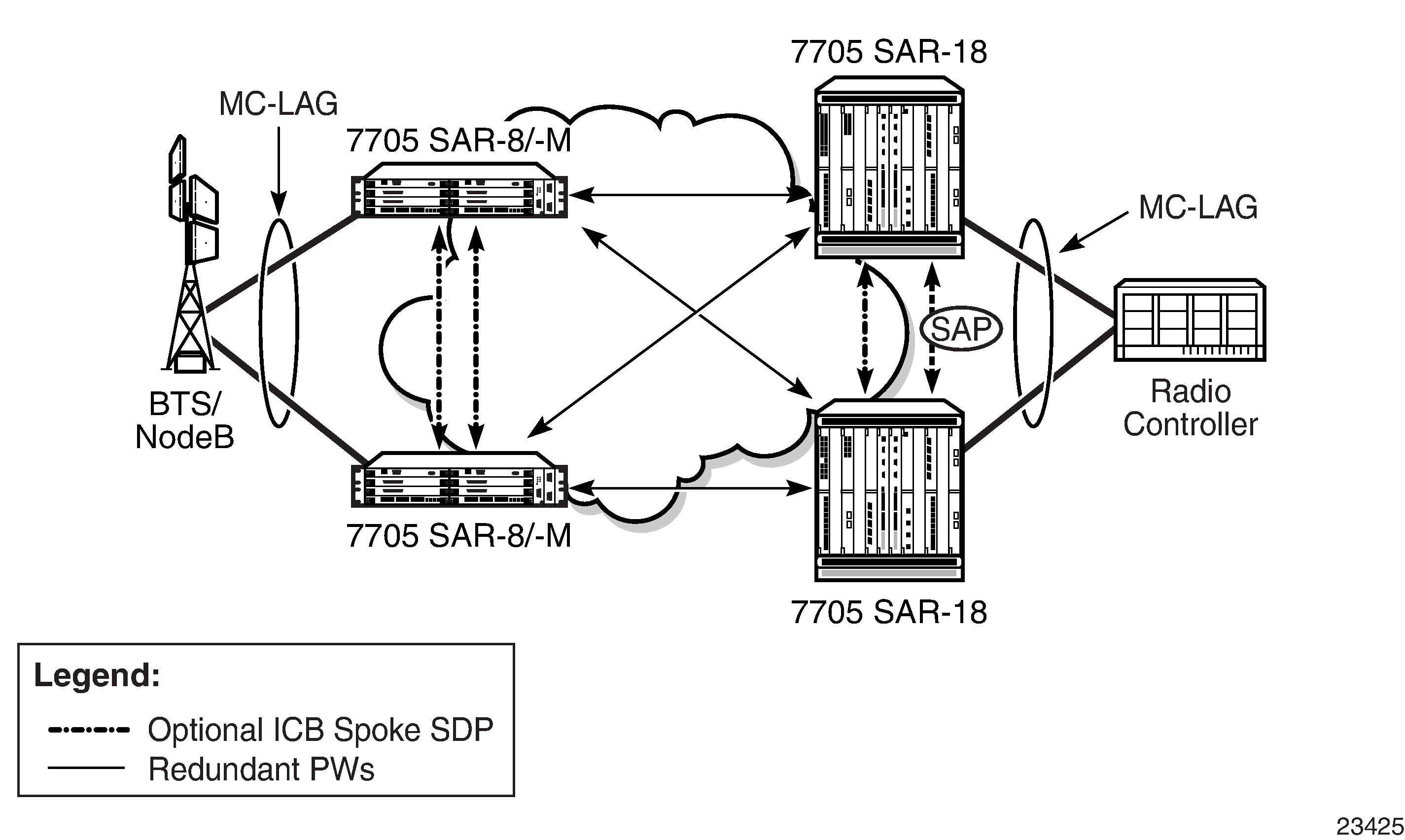Multi-chassis LAG (MC-LAG) prevents service interruptions that are caused by 7705 SAR nodes that are taken out of service for maintenance, upgrades, or relocation. MC-LAG also provides redundancy for incidents of peer nodal failure. This improves network resiliency. When typically used at access or aggregation sites, MC-LAG ensures high availability without service disruptions by providing redundant access or aggregation nodes.
MC-LAG extends the link level redundancy provided by LAG to include protection against failure of a 7705 SAR node. With MC-LAG, a CE device can be connected to two redundant-pair peer nodes. The redundant-pair peer nodes act like a single node, using active/standby signaling to ensure that only one peer node is used at a time. The redundant-pair peer nodes appear to be a single system as they share the same MAC address and system priority when implementing MC-LAG. Availability and status information are exchanged through an MC-LAG Control Protocol (MCCP). It is used to ensure that one peer is active and to synchronize information between the peers.
A peer is configured by specifying its IP address, to which the MCCP packets are sent. The LAG ID, system priority, and MAC address for the MC-LAG are also configured under the peer. Up to 16 MC-LAGs can be configured and they can either use the same peer or different peers up to a maximum of 4 peers.
It is possible to specify the remote LAG ID in the MC-LAG lag command to allow the local and remote LAG IDs to be different on the peers. If there are two existing nodes which already have LAG IDs that do not match, and an MC-LAG is created using these nodes, then the remote LAG ID must be specified so that the matching MC-LAG group can be found. If no matching MC-LAG group is found between neighbor systems, the individual LAGs operates and no MC-LAG operation is established.
Two timer options, keep-alive-interval and hold-on-neighbor-failure, are available in the MC-LAG configuration. The keep-alive-interval option specifies the frequency of the messages expected to be received from the remote peer and is used to determine if the remote peer is still active. If hold-on-neighbor-failure messages are missed, then it is assumed that the remote peer is down.
Figure: MC-LAG at Access and Aggregation Sites shows an example of MC-LAG deployed at access and aggregation sites.

Inter-Chassis Backup (ICB) spoke SDPs are supported for use with Epipe services in an MC-LAG configuration. ICB spoke SDPs provide resiliency by reducing packet loss when an active endpoint is switched from a failed node of an MC-LAG group to a standby node. For example, if a port on an active MC-LAG node fails, the port on one of the peers becomes active, but traffic continues to route to the previously active MC-LAG node until it detects the failure. ICB spoke SDPs ensure that in-flight packets are delivered to the newly active MC-LAG node. Two ICB spoke SDPs must be created. The ICB associated with the MC-LAG on the first node must be associated with the pseudowire on the second node. Likewise, the ICB associated with the MC-LAG on the second node must be associated with the pseudowire on the first node.
Enabling the LAG slave-to-partner parameter ensures synchronized activity switching between the multi-chassis and the single-chassis endpoints. When multi-chassis endpoints are configured in slave-to-partner mode, multi-chassis endpoints always follow the single-chassis activity. The link that is promoted as active via the single-chassis endpoint is used as the active link. Enabling slave-to-partner ensures that out-of-sync scenarios do not occur for the LAG. A multi-chassis pair with pseudowire redundancy and ICBs is always able to direct traffic to the active endpoint, so enabling slave-to-partner does not impose any risk on the network side.
MC-LAG includes support for hash–based peer authentication, configurable heartbeat timers between peers, heartbeat multiplier, LAG bound to MC-LAG with LACP and support for any valid IP link between peers for the multi-chassis Control Protocol (MCCP). MC-LAG supports a configurable fault propagation delay and also provides an option to shut down a MEP on a standby endpoint.
MC-LAG maintains state across a CSM switchover event. The switchover event is transparent to peer MC-LAG nodes where sessions and state are preserved. MC-LAG is supported on the following platforms, adapter cards, and modules:
8-port Gigabit Ethernet Adapter card
6-port Ethernet 10Gbps Adapter card
10-port 1GigE/1-port 10GigE X-Adapter card (supported on the 7705 SAR-18 only)
Packet Microwave Adapter card
6-port SAR-M Ethernet module
7705 SAR-M (the port must be in access mode and autonegotiation must be off or limited)
7705 SAR-X
The 7705 SAR only supports MC-LAG for Epipes and VPLS.